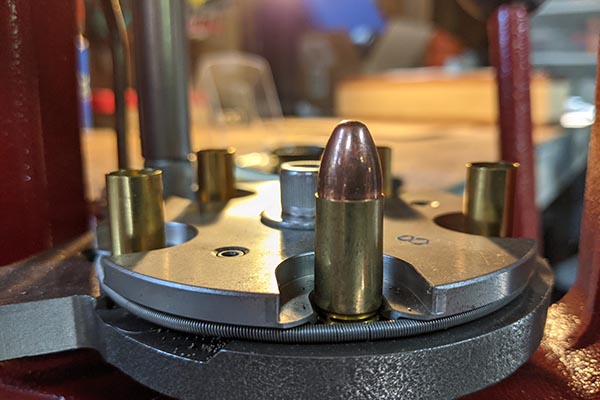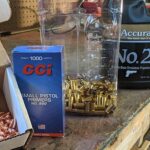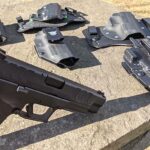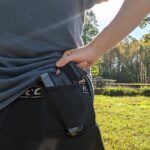If you’re just getting into reloading, you probably have a bunch of questions about costs and benefits. Well today I’ll be discussing the 3 major types of reloading presses and the basics of how each one operates. Choosing a single stage vs. turret vs. auto progressive reloading press will drastically impact your success depending on your goals.
Table of Contents
What Is A Single-Stage Reloading Press?
A single stage reloading press is limited to performing one step of the reloading process at a time. Additionally, only one case is loaded into a single shell holder for processing.
Because only one die can be inserted into the press frame each step in the reloading process is done separately. Therefore, each individual case goes through the press before changing the reloading die.
Additionally, the anatomy of a single stage press is much simpler than a turret or progressive press. Therefore, reloading with a single stage press is mostly manual. However, a single stage press is usually preferred for loading rifle cartridges or when loading match performance ammunition.
How To Use A Single Stage Press?
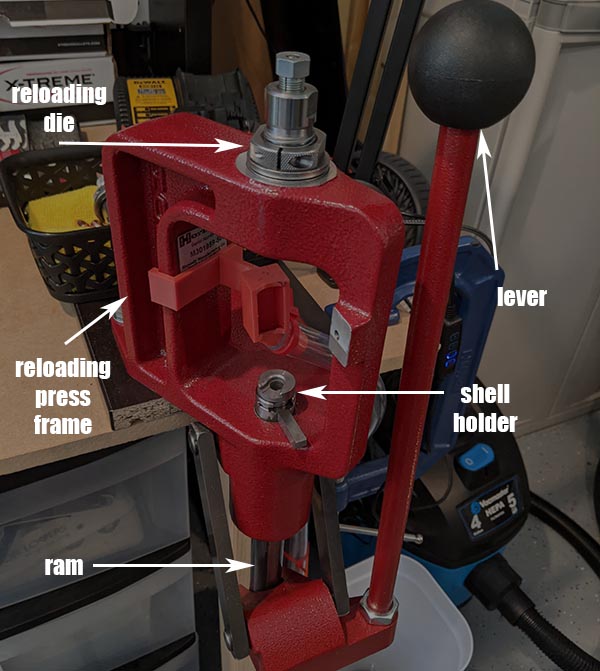
All reloading presses operate similarly. However, reloading press designs vary to make the reloading process more efficient. Functionally, a lever is pulled actuating the ram and modifying or loading the case.
If you want to know more about the reloading process, I recommend reading my article on the steps for reloading handgun ammunition. Although there are additional steps involved in reloading rifle ammunition, the reloading process is very similar.
To operate a single stage reloading press, load the desired die into the frame. Next, place a single case into the shell holder. Afterwards, pull the lever to actuate the ram and allow the die to perform an action. Finally return the lever to the original position and remove the case from the holder.
Because a single stage press can only hold one die at any given time, all cases must be processed before swapping out the reloading die. Therefore, if you are loading 50 rounds all cases should be resized before changing the die.
What Is A Turret Reloading Press?
Unlike a single stage press, a turret reloading press can have multiple different dies loaded into a turret ring. Functionally, a turret press can be operated in single stage or progressive and is a blend between the two.
Additionally, a turret press is more efficient because a single case can be run through multiple steps in the reloading process.
However, a turret press is similar to a single stage press because only a single case can be loaded into the press at one time.
How Does A Turret Press Work?
A turret press is a blend between a single stage press and a progressive press.
To operate a turret press in single stage, follow the same process outlined for a single stage reloading press.
Load a single case into the shell holder and perform the desired action (e.g. resizing) before removing the case and loading another into the press. Once all cases are complete, manually index (rotate) the turret to the corresponding die for the next step. Repeat this process for each case before continuing on.
Alternatively, to operate a turret press progressively leave a single case in the shell holder for multiple stages. Therefore, load a single case into the shell holder. Actuate the ram (i.e. pull the lever) and return it to the original position. Without removing the case, index the turret ring to the desired die. Repeat this process for a single case until you must remove the shell to continue reloading.
The video above shows the manual indexing of the turret ring on the RCBS Turret Press.
What Is An Auto Progressive Reloading Press?
An auto progressive press is the assembly line version of a reloading press. Multiple cases can be loaded into the press at one time. Each pull of the lever indexes (rotates) the shell plate. Consequently, cases move through the various reloading dies and stations before the cartridge is complete.
Therefore, an auto-progressive press is the most efficient way to reload ammo. A case can go from shell to completed cartridge without ever removing the case making this ideal for reloading handgun ammunition. Although there are many accessories you can buy for an auto-progressive press, there is still a human element.
The case and bullet are manually placed by the user, unless you purchase an accessory. Find out how an auto-progressive reloading press works below.
How An Auto-Progressive Press Works
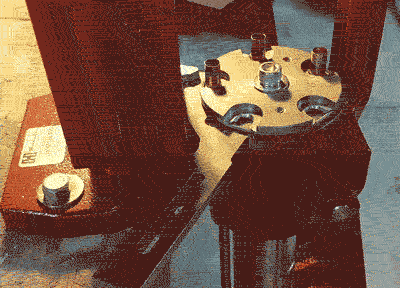
Auto-progressive reloading press shell plate rotating
Auto-progressive presses are capable of holding multiple casings inside a shell plate holder. An auto progressive press works by indexing (rotating) the shell holder plate with each pull of the handle. As the plate turns, a case is aligned with the next die or station in the reloading process. Ultimately, a single reloaded cartridge is ejected from the shell plate holder.
Reloading Die Sequence

Reloading dies are sequentially located within the frame. Each die performs a specific action. Therefore, the order of reloading dies correlates with the step in the reloading process.
First a case is loaded into the shell plate below the decapping and sizing die, which is responsible for removing the spent primer and reshaping the case.
Next the initial case is moved to the priming station where a new primer is seated. Additionally a new case is loaded into the shell plate holder under the decapping and sizing die. Henceforth, a new case is loaded below the decapping and sizing die with each pull of the handle.
After the case has been primed, the case then gets a powder charge. Afterwards, the initial case moves onto the flaring die, which flares the case mouth so a bullet can be placed into the cartridge. Finally, the bullet is seated and the case is crimped using the crimp die.
Human Input On An Auto-Progressive Press
A new case is loaded into the reloading press prior to each pull of the handle. Although there are reloading press accessories that perform this action, a simple setup will require the person reloading to place each case.
Similarly, the bullet for each cartridge must be placed manually by the person reloading. However, there are accessories you can purchase for this action too.
Single Stage vs. Turret vs. Progressive Press Differences
The main difference between a single stage, turret, and auto progressive reloading press is the efficiency of cartridge production. Additionally, the user control and input on the reloading process vary by type of press.
Cost is another difference between the different types of reloading presses. Single-stage reloading presses tend to be less expensive to setup. However, the cost of reloading extends beyond the press itself as items such as shell plate holders, reloading dies, and more can vary the cost greatly.
Parting Shots
Hopefully this has provided some clarity about the differences between a single stage, turret, and auto progressive reloading press. A single stage press is generally used for reloading rifle ammo or for learning the reloading process. However, a progressive press is easier for reloading handgun ammo.
If you have something to add please leave a comment. If you found this content helpful, please share with your network, and as always thanks for checking out the site.
